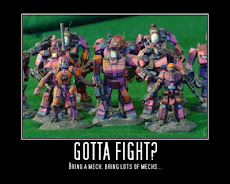
Well this weeks post offers me a respite from crunching numbers, because I have been busy working on making terrain boards to play games on. I have a thread over on one of the BattleTech boards.
This started of as a tutorial thread, which as metamorphosised into an experiential diary of my travails into making terrain.
The boards I first started on are now going through yet another upgrade from their original finish. Each time I try something new, it is a case of two steps forward and one back, but the terrain looks better each time. I don't think I'm yet at the stage that I'm producing terrain that looks real, though that would be nice, I'm not sure that it is achievable within the remit I've set myself, namely terrain to play games on.
Therefore, my boards are designed to be robust, yet light, and unfortunately that comes at a price.
Quite frankly you could do what I have done at less cost by going to one of the terrain making companies that advertise, for instance TSS.
I kid you not that I have spent several hundred pounds building my 45 terrain boards, some of which are still to be finished. And that is without adding a nominal cost for the hours that I have spent making, sculpting, and painting them.
I've even bought a static grass applicator off eBay, which is much cheaper than the Nock Gras Master. I call mine the Grassinator.
All the usual disclaimers here, I'm just a satisfied customer.
Of course, if you buy a bunch of terrain you won't have the hours of fun I've had doing what I call "adult finger painting". Also, as I said, my terrain boards are pretty tough, and can be walked on in stockinged feet. Boots might be a bit too much for them, but it would be a close call.
The same can not be said of most commercial terrain boards, with a few notable exceptions that use injection moulded parts, and even then I'm not sure they wouldn't crack under the weight? Anyway enough of the talk, here is a picture, enjoy.







.png)





Wow that looks very nice.
ReplyDeleteHow big is each of those boards? And are they made to have any degree of interchangability?
Each board is square, which is 10 x 10 inches, or 250 x 250 millimetres on each side. Why this size, why not 12 inches/300mm? In a word variety. I have quite a small dining table in my flat, and can only place 3 x 5 boards on top of it with them overhanging the sides. If I were using larger squares I would get even less combinations of terrain.
ReplyDeleteWhat I did before starting to make these boards was plan what I wanted to have. I knew I would want to have a river delta, and some big hills and ridge lines etc. So the first thing I did was measure out squares onto a sheet of paper and then sat down and drew different types of terrain. I planned all the rivers would be a fixed width and they would enter and exit in the middle of each board. I drew all the hills with their contour lines matching each other.
So you can see that I have about three times as many boards as I can physically place down for any one game, but this allows me to ring the changes and vary the terrain each time. Obviously, some boards that have large hills, or the river boards do have to go together in ways that fit, but other than that everything is pretty flexible.
I also plan to make a folding top to go on top of my dining table, which will allow me to extend the playing surface to 4 x 5, without any overhanging of the tiles.